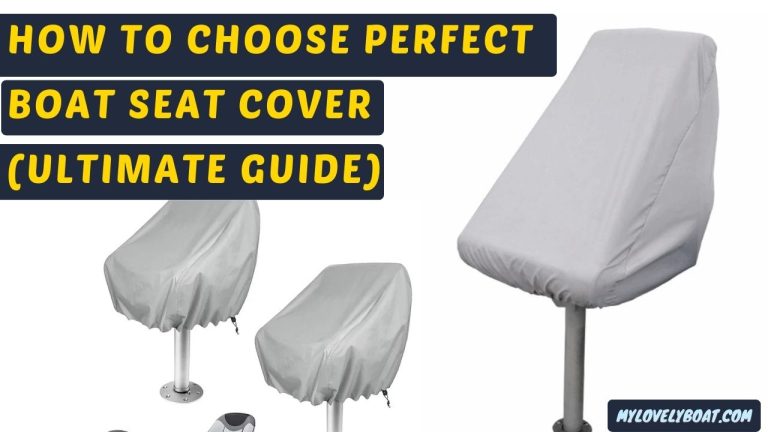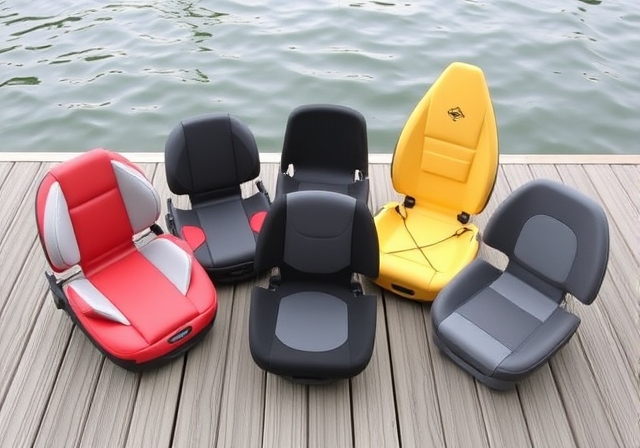
Are you tired of seeing dirt, grime, and mildew on your boat seats and wondering if there’s an easy, cost-effective solution? In this article, we will explore the age-old question: “Can I use vinegar to clean boat seats?” and provide valuable insights to maintain your boat seats’ pristine condition.
Yes, you can use vinegar to clean boat seats! Vinegar is an excellent natural cleaning agent that removes dirt, grime, and mildew from various surfaces, including boat seats. It is an affordable and eco-friendly alternative to harsh chemical cleaners. However, there are both benefits and drawbacks to using vinegar for this purpose.
The Science Behind Vinegar
Vinegar is a solution of acetic acid (CH3COOH) in water, which gives it its characteristic sour taste and pungent smell. Its acidic nature makes it an excellent cleaning agent, as it can dissolve mineral deposits, grease, and grime.
Scientific Studies and Research
Research has shown that vinegar’s acidity effectively kills bacteria, mould, and other germs. A study by the University of North Carolina found that a 5% vinegar solution could kill 99% of bacteria, 82% of mould, and 80% of germs.
How to Clean Boat Seats with Vinegar: A Step-by-Step Guide for Sparkling Clean Upholstery
Boat seats are exposed to various elements, such as sun, water, and dirt, making them look old and worn out. Regular cleaning is essential to maintain their appearance and prolong their lifespan. In this section, we’ll provide a step-by-step guide to cleaning boat seats with vinegar, tips, and tricks for achieving the best results, and safety precautions to remember.
Step 1 – Gather Your Materials And Tools:
Before cleaning, ensure you have all the necessary materials and tools. This will make the task more efficient and hassle-free. Here’s what you’ll need:
- White vinegar: A natural, gentle, and effective cleaning agent for various surfaces, including boat seats
- Water: For diluting the vinegar and rinsing the seats after cleaning
- Spray bottle: To evenly apply the vinegar solution to the boat seats
- Soft brush or sponge: For gently scrubbing the boat seats without causing damage to the upholstery
- Clean, dry towels: For wiping away dirt, moisture, and any residue after cleaning
- Bucket: To hold the water and vinegar mixture during the cleaning process, making it easy to dip your sponge or brush as needed
By gathering these materials and tools beforehand, you’ll be well-prepared to tackle cleaning your boat seats, ensuring they remain in top condition and look their best.
Step 2 – Prepare The Cleaning Solution
Creating a suitable cleaning solution is crucial to clean your boat seats effectively. White vinegar and water are excellent choices for a natural, gentle, yet efficient solution. Follow these steps to prepare your vinegar-based cleaning mixture:
- In the spray bottle, mix equal parts of white vinegar and water. This combination will help remove dirt, stains, and mildew without damaging the boat seat upholstery.
- If you prefer a more robust solution, you can use undiluted vinegar. However, be cautious and test it on a small, inconspicuous area before applying it to the entire seat.
- Consider adding a few drops of dish soap to the mixture for added cleaning power. This will help break down stubborn dirt and grime more effectively.
Step 3 – Remove Loose Dirt and Debris
Before using the vinegar-based cleaning solution, removing any loose dirt and debris from the boat seats is essential. This will prevent scratches and make the cleaning process more efficient. Follow these steps to prepare your boat seats for cleaning:
- Inspect the boat seats for any visible dirt, dust, or debris that may have accumulated over time.
- Using a soft brush or a dry towel, gently brush off the loose dirt and debris from the surface of the seats. Be sure to cover all areas, including seams and crevices.
- Use a vacuum cleaner with a brush attachment to remove any stubborn debris trapped in tight spaces.
Step 4 – Apply the Vinegar Solution
Once the loose dirt and debris have been removed, it’s time to apply the vinegar-based cleaning solution to your boat seats. This will help break down any remaining dirt, stains, and mildew. Follow these steps to use the vinegar solution effectively:
- Shake the spray bottle containing the vinegar mixture to ensure the components are well combined.
- Spray the vinegar solution liberally onto the boat seats, covering all areas, including seams and crevices.
- Allow the solution to sit on the seats for a few minutes. This will give the vinegar time to penetrate the dirt and grime, making removing it easier.
Step 5 – Scrub The Boat Seats
After allowing the vinegar solution to penetrate the dirt and grime, it’s time to scrub the boat seats gently. This will help remove any stubborn stains and restore the appearance of your boat’s upholstery. Follow these steps for effective scrubbing:
- Choose a soft brush or sponge to avoid damaging the seat material during cleaning.
- Gently scrub the boat seats in a circular motion, working the vinegar solution into the upholstery to break down dirt and stains.
- Pay extra attention to seams, crevices, and any stained areas, as these spots may require more effort to clean thoroughly.
- Be sure to cover the entire surface of the boat seats, ensuring no areas are left uncleaned.
Step 6 – Wipe The Seats Clean
Once you’ve finished scrubbing the boat seats, the final step is to clean them and remove any remaining dirt and vinegar solution. This will leave your boat seats looking fresh and well-maintained. Follow these steps to complete the cleaning process:
- Take a clean, dry towel and gently wipe the boat seats, removing any lingering dirt, grime, and vinegar solution.
- If necessary, use a separate towel or sponge dampened with clean water to rinse the seats, removing all traces of the cleaning solution.
- Thoroughly dry the boat seats with a clean towel to prevent moisture-related issues like mold or mildew growth.
- Inspect the seats to ensure they are clean and free of dirt or stains.
By wiping the seats clean and thoroughly drying them, you’ll complete the cleaning process and ensure your boat seats remain in excellent condition for future boating adventures.
Tips and Tricks for Achieving the Best Results
- To remove stubborn stains, apply undiluted vinegar directly to the affected area and let it sit for a few minutes before scrubbing.
- To neutralize the vinegar smell, add a few drops of essential oil (like lavender or lemon) to the cleaning solution or use a fabric freshener after cleaning.
- Clean your boat seats regularly to prevent dirt buildup and reduce the need for heavy scrubbing.
- For added protection, consider applying a UV protectant spray to your boat seats after cleaning to prevent sun damage.
Safety Precautions and Warnings When Using Vinegar as a Cleaning Agent
- Always test the vinegar solution on a small, inconspicuous area of the boat seat before applying it to the entire surface to ensure it doesn’t cause discoloration or damage.
- Avoid using vinegar on natural stone surfaces, such as marble or granite, as it may etch the material.
- Do not mix vinegar with bleach; it can create toxic chlorine gas.
- Wear gloves when handling undiluted vinegar to protect your skin from irritation.
Advantages and Disadvantages of Using Vinegar for Cleaning Boat Seats
Cleaning boat seats is essential for maintaining their appearance and prolonging their lifespan. While various cleaning agents are available, vinegar has gained popularity as a natural and cost-effective alternative. We’ll discuss the pros and cons of using vinegar for cleaning boat seats and compare it to other commonly used cleaning agents.
Pros of Using Vinegar:
- Eco-friendly: Vinegar is a biodegradable and non-toxic cleaning agent, making it an environmentally friendly choice compared to chemical-based cleaners.
- Cost-effective: Vinegar is inexpensive and readily available, making it an affordable option for boat owners.
- Gentle on upholstery: Vinegar is safe for most boat seat materials, including vinyl, fabric, and leather, and is less likely to cause damage or discoloration than harsh chemicals.
Cons of Using Vinegar:
- Strong smell: The pungent smell of vinegar can be off-putting to some people, although it typically dissipates once the seats are dry.
- Less effective on stubborn stains: Vinegar may not be as powerful as commercial cleaners for removing heavy grime or stubborn stains.
Comparison with Other Cleaning Agents
Commercial boat seat cleaners and upholstery cleaners are designed to tackle dirt, stains, and mildew on boat seats. While they may be more effective at removing stubborn stains, they often contain harsh chemicals that can harm the environment and may cause damage to the upholstery over time.
Commercial Boat Seat Cleaners:
- Star Brite Ultimate Vinyl Clean: This powerful cleaner is designed to remove dirt, stains, and mildew from vinyl boat seats. It contains UV inhibitors to protect against sun damage and is safe for all vinyl surfaces.
- 303 Marine Fabric & Vinyl Cleaner: This versatile cleaner removes stains and dirt from fabric and vinyl boat seats. It is non-toxic, biodegradable, and rinses residue-free, leaving your boat seats looking clean and fresh.
In contrast, vinegar is a more eco-friendly and gentle option suitable for regular maintenance and light cleaning. However, a specialized cleaner may be necessary for heavy grime or stubborn stains.
Real-Life Experiences and Testimonials
Many boat owners have successfully used vinegar to clean their boat seats. Here are some testimonials:
“I’ve been using vinegar to clean my boat seats for years, and it works great! It’s cheap, eco-friendly, and doesn’t damage the upholstery.” – John, boat owner
“I was sceptical about using vinegar on my boat seats, but I tried it and was impressed with the results. It removed dirt and mildew without harsh chemicals.” – Karen, the boat owner.
F. A. Q
Is vinegar safe for all types of boat seats?
Vinegar is generally safe for most boat seat materials, including vinyl, fabric, and leather. However, it’s always a good idea to test the vinegar solution on a small, inconspicuous area of the boat seat before applying it to the entire surface to ensure it doesn’t cause discolouration or damage.
Can vinegar damage the upholstery?
Vinegar is a gentle cleaner that usually doesn’t damage upholstery. However, it’s essential to first test the vinegar solution on a small, hidden area to ensure it doesn’t cause discolouration or damage. Additionally, avoid using vinegar on natural stone surfaces, such as marble or granite, as it may etch the material.
How often should I clean my boat seats with vinegar?
Regular cleaning is crucial for maintaining the appearance and prolonging the lifespan of your boat seats. Clean your boat seats with vinegar frequently every few weeks or more if exposed to harsh conditions or heavy use.
Can vinegar remove mould and mildew from boat seats?
Vinegar’s acidity makes it effective at killing mould and mildew. However, you may need a specialized mould and mildew remover or a bleach solution to eliminate the problem of severe mould and mildew infestations.
Do I need to rinse the boat seats after cleaning them with vinegar?
While it’s not always necessary to rinse the boat seats after cleaning with a vinegar solution, it can help remove any remaining dirt and vinegar residue. If you rinse the seats, use clean water and dry them thoroughly to prevent water spots and mould growth.
Read More About Boat Seat:
- How to Clean Your Boat Seats: A Comprehensive Guide
- 10 Tricks to Keep Your Boat Seats Looking New
- How to Store Your Boat Seat Off-Season (10 Ways)
- The Ultimate Guide to Deferent Types of Boat Seats
- Securing Your Boat Seat Cushion: A Comprehensive Guide
- Make Your Boat Seats Less Slippery: (8 Hacks)
- Choosing the Best Boat Seat Cushions for You Need[6 Tips]

I am a freelance writer passionate about watersports and the great outdoors. I have many years of experience in the marine industry, and I enjoy sharing my knowledge and expertise with others so that they can get the most out of their boating experiences. I like fishing, kayaking, and exploring new destinations by boat whenever I have time. Contact Us: Linkedin





